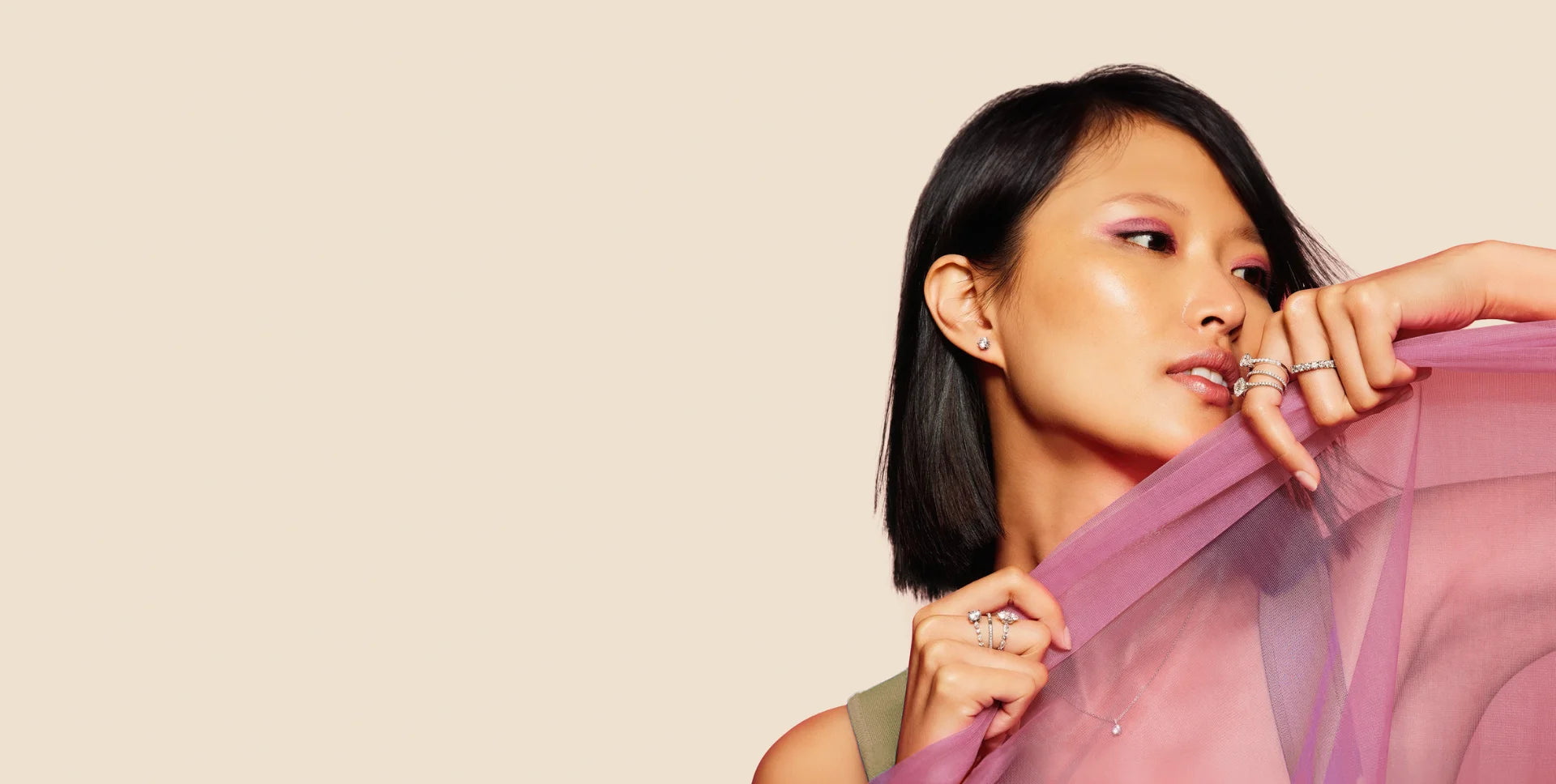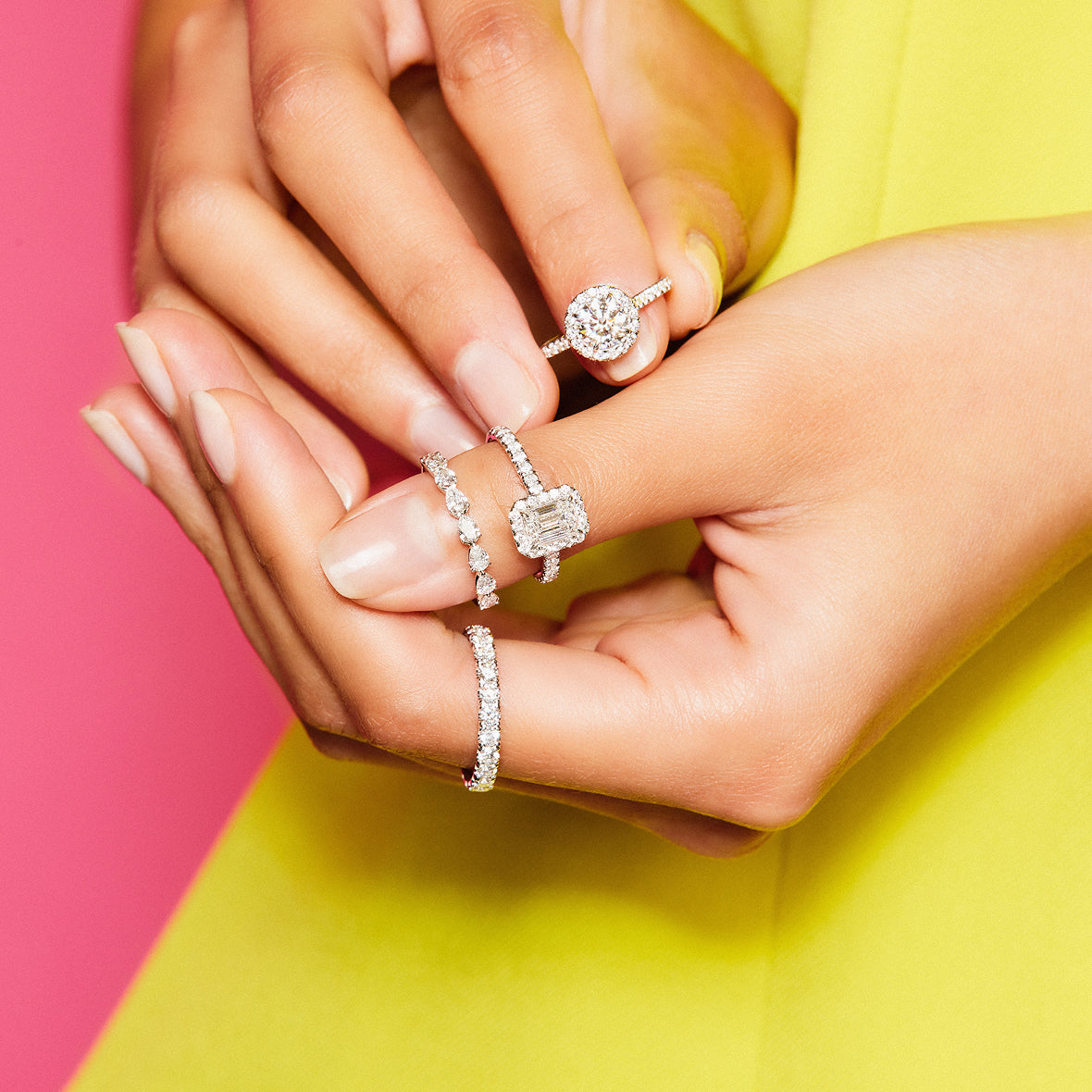Diamond Education
Diamond Cut
Cut describes the symmetry, balance, proportion and polish created by the diamond cutter, not the stone’s actual geometric shape. A diamond’s inherent beauty is determined directly by the expertise of its cut.

Diamond Education
Diamond Cut
Cut describes the symmetry, balance, proportion and polish created by the diamond cutter, not the stone’s actual geometric shape. A diamond’s inherent beauty is determined directly by the expertise of its cut.
Brilliance
A diamond’s brilliance comes alive with its cut, which defines how light enters the gemstone, bounces off its mirrored facets, and radiates in a stunning display of white light.
Scintillation
Scintillation is the dynamic play of light you see when a diamond catches light, giving it that captivating “sparkle in motion.” A well-cut diamond elevates the scintillation, creating a dazzling play of light as it moves.
Dispersion
Diamonds display a dazzling rainbow of colours as light enters the gemstone, breaks into spectral hues, and reflects off multiple facets. This dispersion creates vibrant flashes of light that dance with every movement.
A DIAMOND'S COMPONENTS
Understanding a diamond’s anatomy helps explain how its cut affects brilliance, fire, and dispersion. A superior cut leverages these components to maximise light return and create a stunning balance of sparkle and shine.
Diamond Cut Grade Chart
For further guidance, refer to our diamond cut chart. As the quality of a diamond's cut directly affects its sparkle and beauty, DX Diamonds offers only the finest cut gradings: Very Good, Excellent, and Super Ideal.
How Diamond Cut Impacts Value and Brilliance
Cut has the biggest impact on how a diamond looks, even more than colour or clarity. A well-cut diamond can appear brighter and larger than a poorly cut diamond of the same carat weight. It reflects light more efficiently, creating exceptional brilliance that catches the eye instantly. Even a high-carat diamond will look dull if the cut is shallow or deep. At DX Diamonds, we offer only the finest cut grades to ensure brilliance and beauty. This includes our collection of lab grown diamonds, which are crafted with the same precision and care as our natural gemstones. Our expert craftsmanship guarantees that every lab grown diamond meets the highest standards of quality and sparkle. For lasting value and visual appeal, giving prominence to the diamond cut grade ensures your diamond stands out for all the right reasons.

Balancing Diamond Cut with Other Diamond Characteristics
When choosing a diamond, cut is crucial, but it’s just one of the 4 Cs: Cut, Colour, Clarity, and Carat. At DX Diamonds, we help you balance all four for the best brilliance and value.
At DX Diamonds, we focus on helping our customers find the right balance, so you get maximum sparkle, no matter your budget.
Smart Buying Tips for Aussies: Choosing the Right Diamond Cut
In Australia, buyers are becoming more design-savvy, and that starts with understanding diamond cut. Here’s how to make a confident choice that balances beauty, value, and personal style:
Look for Excellent or Ideal Grades:
This is where true value lies. A diamond with an Excellent or Ideal cut reflects light beautifully, giving it that irresistible sparkle. And at DX Diamonds, that level of quality comes standard in every piece we offer.
Choose a Diamond Shape That Reflects Your Style:
Our collection carries a wide range of diamond shapes for every style, from the understated round and oval cuts to the intricate emerald and princess cuts. Don’t be afraid to experiment with different styles and explore options until you find the one that feels just right.
Think About Your Priorities
Choose what matters most to you if it’s size, sparkle, or flawless clarity. If you’re after maximum visual impact, you might prioritise cut and carat weight. But if you’re all about that brilliant shine, a high-quality cut paired with a slightly lower colour or clarity grade can still deliver a stunning result without blowing the budget.
Keep Budget in Mind:
Choosing a slightly lower colour or clarity can stretch your budget further, especially if you prioritise cut, which makes the biggest difference in sparkle. It's all about getting the best balance for your money.
Consider Lab Grown Diamonds to Maximise Cut Quality:
Lab grown diamonds are an excellent option for those who want to prioritise cut without overspending. Because they offer better value than natural diamonds, you can often afford a higher cut grade that results in greater brilliance and visual impact.
At DX Diamonds, every diamond is selected with precision, so Aussie buyers can shop confidently, knowing sparkle is guaranteed.
WHAT DIAMOND CUT GRADING DO WE RECOMMEND?
To maximise brilliance, we recommend a cut grading of Excellent or Super Ideal for round diamonds, and Very Good, Excellent or Super Ideal for fancy shapes (non-rounds)
WHAT IS THE DIFFERENCE BETWEEN 'EXCELLENT' & 'SUPER IDEAL' CUT?
'Excellent' and 'Super Ideal' are top diamond cut grades, ensuring maximum brilliance. Super Ideal diamonds, a step above, have stricter standards for exceptional beauty. Despite a slight premium, DX sees them as offering fantastic value.
BROWSE BY SHAPE
Cut describes the symmetry, balance, proportion and polish created by the diamond cutter, not the stone’s actual geometric shape. Discover a range of shapes available right here.
Round
Oval
Cushion
Pear
Emerald
Princess
Radiant
Heart
Marquise
Asscher